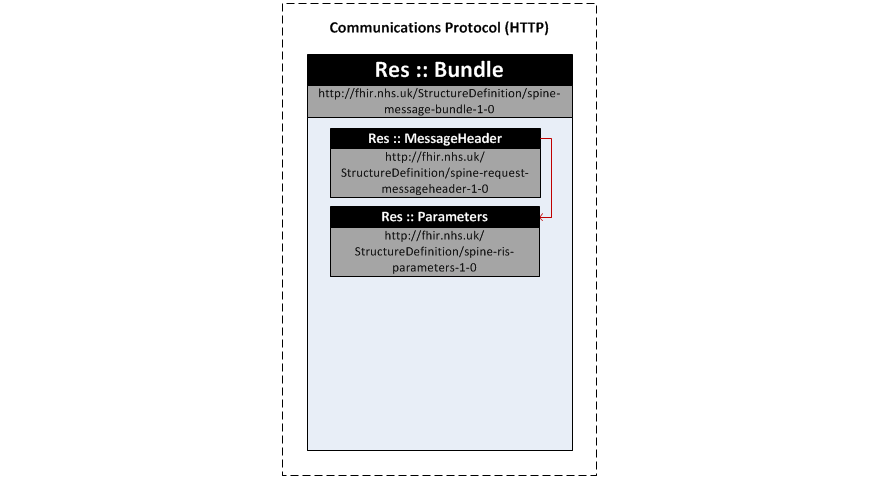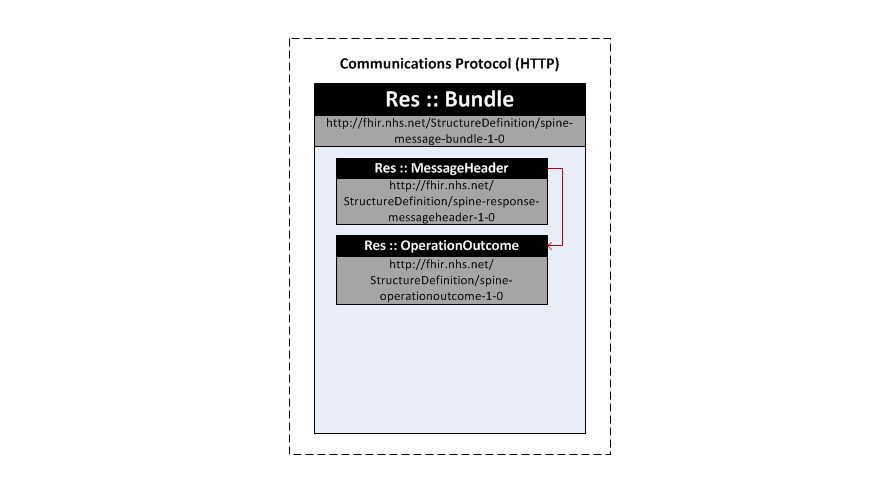FGM Risk Indication System Spine 2 interface Overview
This section provides FGM implementers with an overview of the FGM Risk Indication System Spine 2 FHIR interface also known as the 'FGM Service'.
It should be read in conjunction with the 'FGM Service' Implementation Guide: FGM_implementation_guide-v1.
The FGM Service provides a read only interface to the Spine 2 FGM Risk Indication System in order to access the FGM status of a patient. The FGM Service is based on the HL7 FHIR DSTU2 1.0.1 Messaging Implementation (Sept 2015) Messaging Implementation.
FGM Risk Indication System Spine 2 Interactions
The FGM Risk Indication System Spine 2 interface supports 5 interactions:
Assuming successful transport, there are three possible outcomes to the Query Request:
FGM Risk Indication System Spine 2 Interaction Diagram
The diagram shows the FGM Risk Indication System Spine 2 Interactions:

FGM FHIR Message Patterns and Structures
In FHIR messaging, a "message" is sent from a source application to a destination application when an event happens. Events mostly correspond to things that happen in the real world.
The FGM Service utilises a synchronous request / response pattern. It is synchronous with respect to HTTP connections which means that only a single HTTP connection is required to perform a complete request.
This message communication pattern is similar to the Spine 1 'Web Service Mode'. However, as the FHIR message payload contains the required sender and receiver endpoint information there is no longer any need to support the legacy HL7 v3 transport wrapper, WS-Addressing or for the SOAP header information within the structure.
The FGM request / response FHIR message payloads consist of combined FHIR resources that are bundled together within a FHIR Bundle wrapper to form the FHIR message structure. The Bundle resource is a container for a collection of resources identified by the type "message", with the first resource in the bundle being a MessageHeader resource.
The MessageHeader resource has a message event code (MessageHeader.event.code) that identifies the nature of the request/ response message. The message event in FGM is the SOAPAction (service and action) URI once carried as an HTTP Header e.g. urn:nhs:names:services:clinicals-sync:FGMQuery_1_0
The MessageHeader.source.endpoint and the MessageHeader.destination.endpoint elements identify the sender and receiver addresses and are used for authorisation and audit purposes. An example of a sender address URN is: urn:nhs:addressing:asid:047192794544
Any resources referenced in the MessageHeader or child resources must be included in the bundle.
QU01-FGM Query Request Bundle
The FGM Query Request Bundle is conveyed when the FGM Service is queried by an NHS system that uses Spine RBAC. The 'Spine-Message-Bundle-1-0' bundle resource profile is used as a container to collect the FGM RIS Query resources in the following combined order:
The diagram shows the bundling of the FGM Query resources within the FHIR message payload, transported over HTTP:

QU02-SMSP FGM Query Request Bundle
The SMSP FGM Query Request Bundle is conveyed when the FGM Service is queried by an NHS system that does not use Spine RBAC. The 'Spine-Message-Bundle-1-0' bundle resource profile is used as a container to collect the SMSP FGM RIS Query resources in the following combined order:
NB: The MessageHeader.source.endpoint element carries the ASID identifier used to audit non-smartcard interactions with the FGM Service.
The diagram shows the bundling of the FGM Query resources within the FHIR message payload, transported over HTTP:

RSP01-Invalid Query Bundle
The 'Spine-Message-Bundle-1-0' Bundle resource profile is used in the FGM outbound interface as a container to collect the 'Invalid Query' FGM RIS Query Response resources in the following combined order:
The diagram shows the bundling of the 'Invalid Query' FGM RIS Query Response resources within the FHIR message payload, transported over HTTP:

RSP02-FGM Entry Found Bundle
The 'Spine-Message-Bundle-1-0' bundle resource profile is used in the FGM outbound interface as a container to collect the 'FGM Found' FGM RIS Query Response resources in the following combined order:
The diagram shows the bundling of the 'FGM Found' FGM RIS Query Response resources within the FHIR message payload, transported over HTTP:

RSP03-No FGM Entry Found Bundle
The 'Spine-Message-Bundle-1-0' Bundle resource profile is used in the FGM outbound interface as a container to collect the 'No FGM Found' FGM RIS Query Response resources in the following combined order:
The diagram shows the bundling of the 'No FGM Found' FGM RIS Query Response resources within the FHIR message payload, transported over HTTP:

Further Information
For more information about FHIR messaging please visit: HL7 FHIR DSTU2 1.0.1 Messaging Implementation and for the 'FGM Service' see: FGM_implementation_guide-v1: FGM_implementation_guide-v1.pdf.
Quick links to FHIR reference implementations and implementation tool downloads are available from the FHIR DSTU2 1.0.1 (Sept 2015) specification.